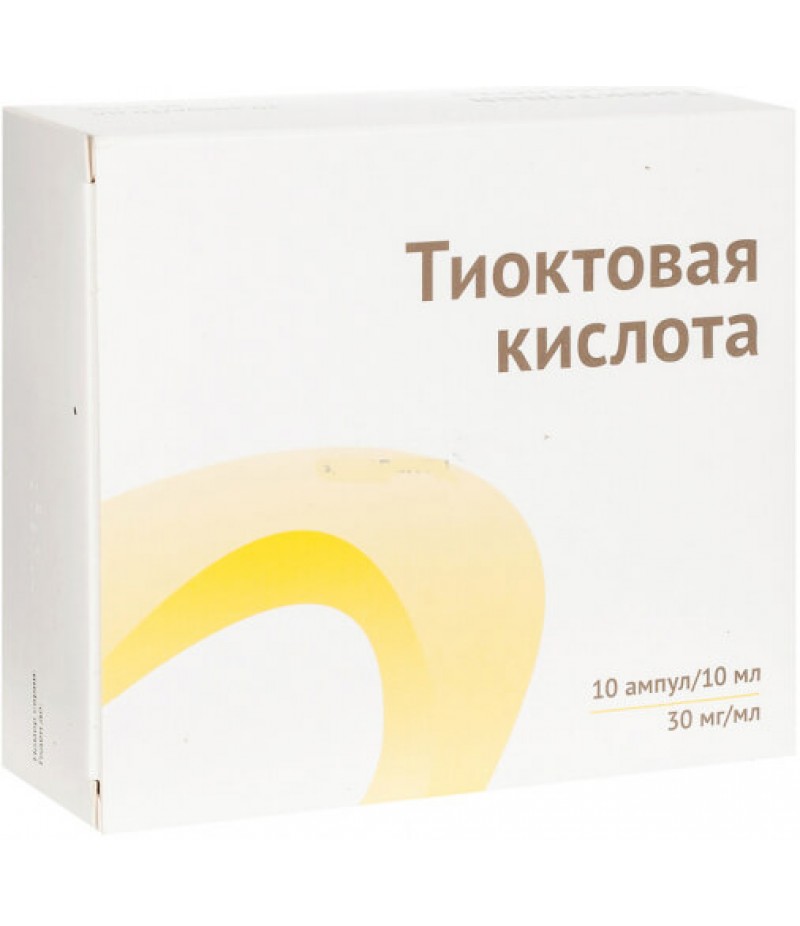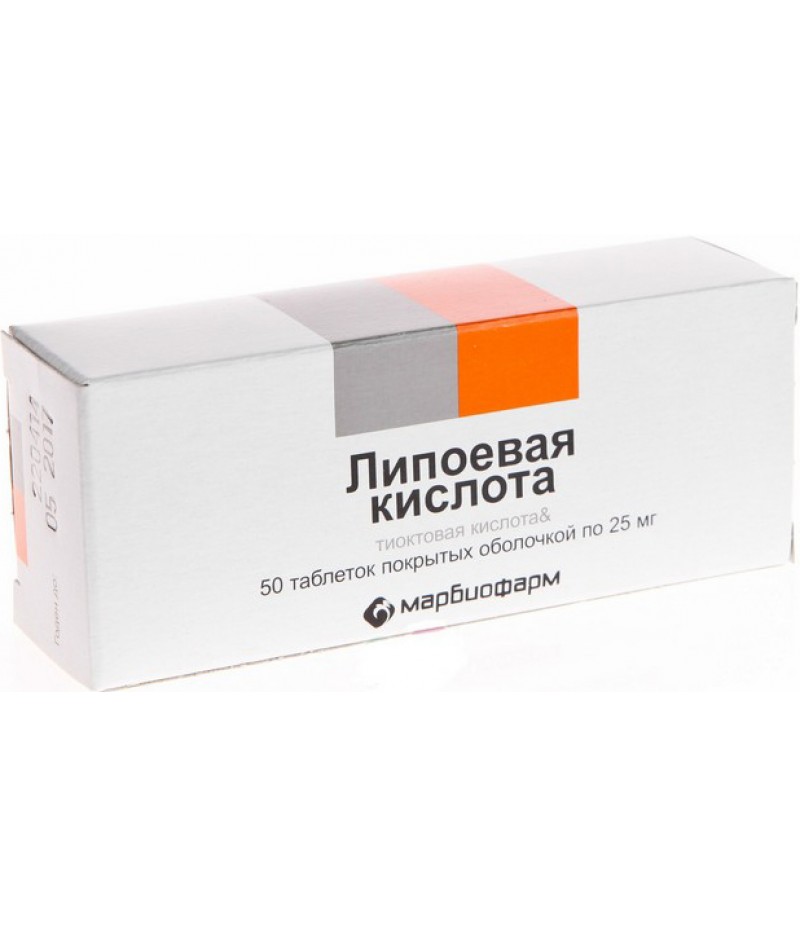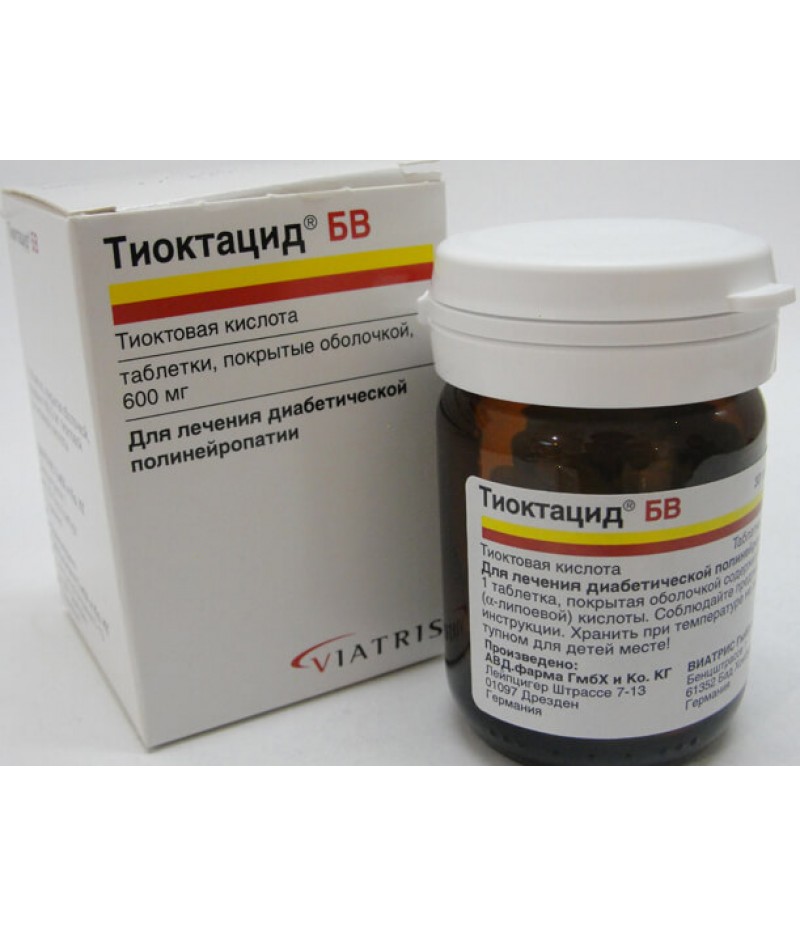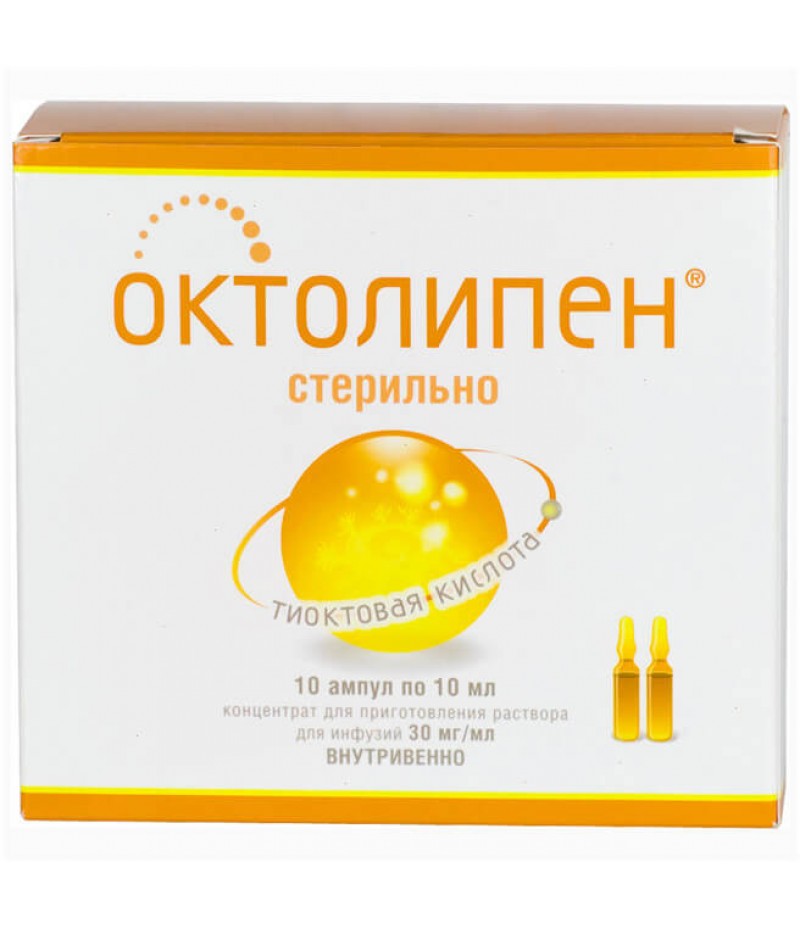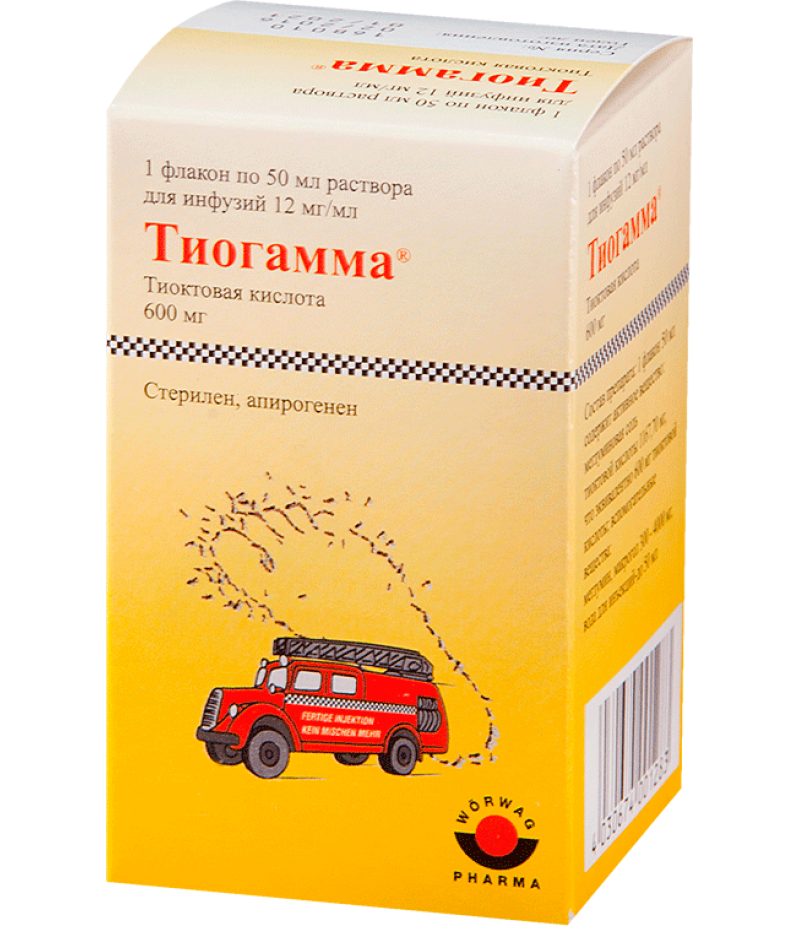Thioctic acid for infusions 30mg/ml 10ml #10
- $22.56
- 3 or more $22.49
- Availability:In Stock
Thioctic acid instructionYou can buy Thioctic acid hereIngredients: 1 ml:Active ingredient: thioctic acid (α-lipoic acid) - 30.0 mg;Excipients: ethylene diamine - 8.8 mg; propylene glycol - 93.2 mg; water for injection - up to 1 m..
Thioctic acid instruction
You can buy Thioctic acid here
Ingredients: 1 ml:
Active ingredient: thioctic acid (α-lipoic acid) - 30.0 mg;
Excipients: ethylene diamine - 8.8 mg; propylene glycol - 93.2 mg; water for injection - up to 1 ml.
Description: Transparent liquid of greenish-yellow color, with a characteristic smell.
Pharmacotherapeutic group: metabolic agent
ATC:
A.16.A.X.01 Thioctic acid
Pharmacodynamics
Thioctic (alpha-lipoic) acid is an endogenous antioxidant of direct (binds free radicals) and indirect action. As a coenzyme, mitochondrial multienzyme complexes are involved in the oxidative decarboxylation of pyruvic acid and alpha keto acids. It helps to reduce the concentration of glucose in the blood plasma and increase the concentration of glycogen in the liver, as well as to overcome insulin resistance. By the nature of the biochemical action is close to the vitamins of group B. Participates in the regulation of carbohydrate and lipid metabolism, stimulates cholesterol metabolism. It has a hepatoprotective, hypolipidemic, hypocholesterolemic, hypoglycemic effect. Improves trophism of neurons.
In diabetes mellitus, thioctic acid reduces the formation of glycation end products, improves endoneural blood flow, increases glutathione content to a physiological value, which results in an improvement in the functional state of peripheral nerve fibers in diabetic polyneuropathy. Due to the participation in the metabolism of fats, thioctic acid increases the biosynthesis of phospholipids, in particular, phosphoinositides, restoring damage to cell membranes; normalizes energy metabolism and nerve impulses. Thioctic acid eliminates the toxic effects of alcohol metabolites (acetaldehyde, pyruvic acid), reduces excessive formation of free oxygen radicals, reduces endoneural hypoxia and ischemia, reducing the manifestations of polyneuropathy in the form of paresthesia, burning sensation, pain and numbness of the extremities.
Thus, thioctic acid has an antioxidant, neurotrophic effect, improves lipid metabolism.
Pharmacokinetics
Distribution
With intravenous administration of thioctic acid in a dose of 600 mg, the maximum plasma concentration in 30 minutes is about 20 μg / ml. The area under the concentration-time curve is about 5 µg / h / ml. Bioavailability - 30%. Thioctic acid has the effect of "first pass" through the liver. The formation of metabolites occurs as a result of side chain oxidation and conjugation. The volume of distribution is about 450 ml / kg.
Metabolism and excretion
Thioctic acid and its metabolites are excreted by the kidneys mainly in the form of metabolites (80-90%), in a small amount - unchanged. The half-life is 25 minutes. Total plasma clearance - 10-15 ml / min / kg.
Indications
- Diabetic polyneuropathy;
- alcoholic polyneuropathy.
Contraindications for Thioctic acid
- Hypersensitivity to thioctic (alpha-lipoic) acid or to other components of the drug;
- pregnancy, breastfeeding period (there is not enough experience with the drug);
- age up to 18 years (efficacy and safety of the drug has not been established).
Carefully
Intravenous administration of the drug should be carried out with caution in elderly patients (over 75 years).
Pregnancy and lactation
The use of thioctic acid during pregnancy is contraindicated due to the lack of sufficient experience of use.
It is not known whether thioctic acid (α-lipoic acid) passes into the mother's milk. If necessary, the use of the drug during breastfeeding, breastfeeding should be stopped.
Dosage and administration
For intravenous administration.
At the beginning of treatment, the drug is administered intravenously in a daily dose of 600 mg (2 ampoules).
Before use, the contents of 2 ampoules (20 ml) are diluted in 250 ml of 0.9% sodium chloride solution and injected intravenously slowly for at least 30 minutes. Since the active substance is sensitive to light, the solution for infusion is prepared immediately before use. The prepared solution must be protected from light exposure, for example, using aluminum foil. Protected from light solution can be stored for about 6 hours.
The course of treatment is 2-4 weeks. Then move on to maintenance therapy with the oral form of the preparation of thioctic acid at a dose of 600 mg per day. The duration of treatment and the need for its repetition is determined by the doctor.
Side effects
Possible side effects when using the drug are listed below in descending frequency of occurrence: often (≥ 1/100 to <1/10); infrequently (≥ 1/1000 to <1/100); rarely (≥1 / 10,000 to <1/1000); very rarely (<1 / 10,000), including individual messages. There is no correlation between the incidence of side effects and gender or age of patients.
Disorders of the hematopoietic system and the lymphatic system: very rarely - petechial hemorrhages in the mucous membranes, skin; hemorrhagic rash (purpura), thrombocytopathy, hypocoagulation.
Immune system disorders: very rarely - allergic reactions (skin rash, eczema, urticaria, pruritus); frequency is unknown - anaphylactic shock; autoimmune insulin syndrome in patients with diabetes mellitus, which is characterized by frequent hypoglycemia in the presence of insulin autoantibodies.
Metabolic and nutritional disorders: very rarely - hypoglycemia (due to improved glucose uptake), symptoms of which include dizziness, increased sweating, headache and visual impairment.
Violations of the nervous system: very rarely - a change or a violation of taste sensations, "tides", convulsions.
Disorders of the gastrointestinal tract: often - nausea, vomiting; very rarely - abdominal pain, diarrhea.
Disorders of the liver and biliary tract: very rarely - increased activity of "liver" enzymes.
Cardiac abnormalities: frequency not known - pain in the region of the heart, tachycardia with rapid administration of the drug.
Vascular disorders: very rarely - thrombophlebitis.
Disorders of the organ of vision: very rarely - diplopia, blurred vision.
General disorders and disorders at the injection site: very rarely - burning sensation at the injection site, frequency not known - allergic reactions at the injection site - irritation, hyperemia or swelling.
Others: very rarely, with rapid intravenous administration, self-elevating intracranial pressure (feeling of heaviness in the head) and difficulty in breathing, weakness were observed.
Overdose
Symptoms: headache, nausea, vomiting.
In severe cases (with the use of thioctic acid in a dose of 10-40 g): psychomotor agitation or impaired consciousness, generalized convulsions, severe acid-base imbalance with lactic acidosis, hypoglycemia (up to the development of coma), acute necrosis of skeletal muscles, DIC , hemolysis, bone marrow suppression, multiple organ failure.
Treatment: if an overdose of thioctic acid is suspected, emergency hospitalization is recommended. Symptomatic therapy. Treatment of generalized seizures, lactic acidosis and other life-threatening consequences of overdose should be carried out in accordance with the principles of modern intensive care. There is no specific antidote. Hemodialysis, hemoperfusion or filtration methods with the forced elimination of thioctic acid are ineffective.
Interaction
Due to the fact that thioctic acid is capable of forming chelate complexes with metals, co-administration with preparations of iron, magnesium, and calcium should be avoided.
The simultaneous use of thioctic acid with cisplatin reduces the effectiveness of the latter.
With sugar molecules, thioctic acid forms poorly soluble complex compounds. Thioctic acid is incompatible with solutions of dextrose (glucose), fructose, Ringer, as well as solutions that react with disulfide or SH-groups.
Thioctic acid enhances the hypoglycemic effect of insulin and hypoglycemic drugs for oral use when used together.
Thioctic acid enhances the anti-inflammatory effect of glucocorticosteroids.
Ethanol and its metabolites reduce the therapeutic efficacy of thioctic acid.
Special instructions
In patients with diabetes mellitus, constant monitoring of plasma glucose concentrations is necessary, especially at the initial stage of treatment with Thioctic Acid. In some cases it may be necessary to reduce the dose of insulin or hypoglycemic drugs for oral administration in order to avoid the development of hypoglycemia. If you experience symptoms of hypoglycemia (dizziness, increased sweating, headache, visual disturbances, nausea), the drug should be stopped immediately.
With parenteral administration, hypersensitivity reactions may occur. If symptoms appear, such as itching, malaise, treatment with Thioctic acid, it should be stopped immediately.
Alcohol intake reduces the effectiveness of drug treatment, so patients during the treatment with Thioctic acid should refrain from alcohol during the entire course of treatment, and, if possible, in the intervals between courses. Alcohol consumption during treatment with thioctic acid is also a risk factor for the development and progression of neuropathy.
The prepared solution of the drug should be protected from exposure to light.
Several cases of the development of autoimmune insulin syndrome in patients with diabetes mellitus during treatment with thioctic acid, which was characterized by frequent hypoglycemia in the presence of autoantibodies to insulin, have been described. The possibility of the development of autoimmune insulin syndrome is determined by the presence of HLA-DRB1 * 0406 and IILA-DRB1 * 0403 haplotypes in patients.
Impact on the ability to drive trans. Wed and fur .
The effect of the drug on the ability to drive vehicles and control mechanisms has not been specifically studied, therefore, during the treatment with Thioctic Acid, caution should be exercised when driving vehicles and practicing potentially hazardous activities that require increased concentration and psychomotor reactions.
Form release / dosage
Concentrate for solution for infusion, 30 mg / ml.
Packaging
On 10 ml in ampoules of light-protective neutral glass type I with a color ring of a break or with a color point and a notch or without a ring of a break, a color point and a notch. One, two or three color rings and / or two-dimensional bar code, and / or alphanumeric coding with or without additional color rings, two-dimensional bar code, alphanumeric coding can be additionally applied to the ampoules.
On 5 ampoules in a blister strip packaging from a film of polyvinyl chloride and aluminum foil lacquered or polymer film or without foil and without film. Or 5 ampoules are placed in a pre-made form (tray) of cardboard with cells for laying ampoules.
1 or 2 blister packs or carton trays together with instructions for use and a capsule ampoule or knife ampoule, or without a capsule ampoule and ampoule knife are placed in a carton (pack).
Storage conditions
In the dark place at a temperature of no higher than 25 ° C. Do not freeze.
Keep out of the reach of children.
Shelf life - 3 years.
Do not use after the expiration date.
Terms of sell
You can buy Thioctic acid without a prescription.

